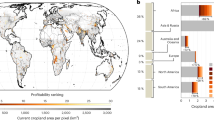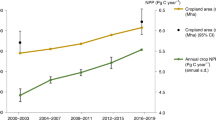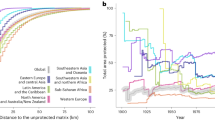Abstract
Protected areas (PAs) are essential for biodiversity conservation but are threatened by cropland expansion. Recent studies have only reported global cropland expansion in large PAs between 1990 and 2005. However, the amount of cropland expansion in global PAs (including relatively small PAs) since the 2000s is unclear. Using 30-m cropland maps, we find that the cropland expansion in PAs accelerated dramatically from 2000 to 2019, compared with that of global croplands. The areal expansion was mainly in large PAs, less-strict PAs and Afrotropical PAs, which also matches the higher species extinction risks. Such PAs appear to be less effective due to greater threats, such as higher background cropland expansion rate. Notably, some PAs with the highest conservation levels failed to prevent cropland expansion. This new picture of cropland dynamics in PAs illustrates that cropland expansion is an ongoing intractable global conservation challenge that will impinge on the aspirations of the post-2020 global biodiversity framework.
This is a preview of subscription content, access via your institution
Access options
Access Nature and 54 other Nature Portfolio journals
Get Nature+, our best-value online-access subscription
27,99 € / 30 days
cancel any time
Subscribe to this journal
Receive 12 digital issues and online access to articles
118,99 € per year
only 9,92 € per issue
Buy this article
- Purchase on SpringerLink
- Instant access to full article PDF
Prices may be subject to local taxes which are calculated during checkout





Similar content being viewed by others
Data availability
All underlying raw model data are publicly available online. Potapov et al.’s cropland data are available at https://glad.umd.edu/dataset/croplands. GlobeLand30 cropland data are available at http://www.globallandcover.com/. AGLC cropland data are available at https://code.earthengine.google.com/?asset=users/xxc/GLC_2000_2015. PA data are freely available online at https://www.protectedplanet.net/en. Expert-derived polygons of amphibians, mammals and reptiles are available online at the IUCN Red List Portal https://www.iucnredlist.org/resources/spatial-data-download. Polygons of bird distributions can be requested from BirdLife International http://datazone.birdlife.org/species/requestdis. Human population density data can be obtained at https://data.worldbank.org/. Human Development Index data are available at https://hdr.undp.org/. Government effectiveness and corruption datasets are available at https://info.worldbank.org/governance/wgi/. Share of GDP on agriculture data are available at https://datacatalog.worldbank.org/search/dataset/0037712/World-Development-Indicators. Source data are provided with this paper.
Code availability
The code that supports our findings is available at https://github.com/ziqi123456/Cropland-expansion-in-globalPAs.
References
Watson, J. E., Dudley, N., Segan, D. B. & Hockings, M. The performance and potential of protected areas. Nature 515, 67–73 (2014).
Gray, C. L. et al. Local biodiversity is higher inside than outside terrestrial protected areas worldwide. Nat. Commun. 7, 12306 (2016).
Protected Planet: The World Database on Protected Areas (UNEP-WCMC & IUCN, 2021); http://www.protectedplanet.net
First Draft of the Post-2020 Global Biodiversity Framework (CBD, 2021); https://www.cbd.int/doc/c/abb5/591f/2e46096d3f0330b08ce87a45/wg2020-03-03-en.pdf
Jones, K. R. et al. One-third of global protected land is under intense human pressure. Science 360, 788–791 (2018).
Geldmann, J., Manica, A., Burgess, N. D., Coad, L. & Balmford, A. A global-level assessment of the effectiveness of protected areas at resisting anthropogenic pressures. Proc. Natl Acad. Sci. USA 116, 23209–23215 (2019).
Powers, R. P. & Jetz, W. Global habitat loss and extinction risk of terrestrial vertebrates under future land-use-change scenarios. Nat. Clim. Change 9, 323–329 (2019).
Potapov, P. et al. Global maps of cropland extent and change show accelerated cropland expansion in the twenty-first century. Nat. Food 3, 19–28 (2022).
Godfray, H. C. et al. Food security: the challenge of feeding 9 billion people. Science 327, 812–818 (2010).
Mogollón, J. M. et al. More efficient phosphorus use can avoid cropland expansion. Nat. Food 2, 509–518 (2021).
Williams, D. R. et al. Proactive conservation to prevent habitat losses to agricultural expansion. Nat. Sustain. 4, 314–322 (2021).
Ward, M. et al. Just ten percent of the global terrestrial protected area network is structurally connected via intact land. Nat. Commun. 11, 4563 (2020).
Guerrero-Pineda, C. et al. An investment strategy to address biodiversity loss from agricultural expansion. Nat. Sustain. 5, 610–618 (2022).
Vijay, V. & Armsworth, P. R. Pervasive cropland in protected areas highlight trade-offs between conservation and food security. Proc. Natl Acad. Sci. USA 118, e2010121118 (2021).
Volenec, Z. M. & Dobson, A. P. Conservation value of small reserves. Conserv. Biol. 34, 66–79 (2020).
Xu, X., Li, B., Liu, X., Li, X. & Shi, Q. Mapping annual global land cover changes at a 30m resolution from 2000 to 2015. Natl Remote Sens. Bull. 25, 1896–1916 (2021).
Chen, J. et al. Global land cover mapping at 30m resolution: a POK-based operational approach. ISPRS J. Photogramm. Remote Sens. 103, 7–27 (2015).
Wolf, C., Levi, T., Ripple, W. J., Zarrate-Charry, D. A. & Betts, M. G. A forest loss report card for the world’s protected areas. Nat. Ecol. Evol. 5, 520–529 (2021).
Murakami, D. & Griffith, D. A. Balancing spatial and non-spatial variation in varying coefficient modeling: a remedy for spurious correlation. Geogr. Anal. 55, 31–55 (2023).
Di Marco, M., Ferrier, S., Harwood, T. D., Hoskins, A. J. & Watson, J. E. M. Wilderness areas halve the extinction risk of terrestrial biodiversity. Nature 573, 582–585 (2019).
Tilman, D. et al. Future threats to biodiversity and pathways to their prevention. Nature 546, 73–81 (2017).
Kehoe, L. et al. Biodiversity at risk under future cropland expansion and intensification. Nat. Ecol. Evol. 1, 1129–1135 (2017).
Sekercioglu, C. H. et al. Long-term declines in bird populations in tropical agricultural countryside. Proc. Natl Acad. Sci. USA 116, 9903–9912 (2019).
Newbold, T. et al. Global effects of land use on local terrestrial biodiversity. Nature 520, 45–50 (2015).
Jayathilake, H. M., Prescott, G. W., Carrasco, L. R., Rao, M. & Symes, W. S. Drivers of deforestation and degradation for 28 tropical conservation landscapes. Ambio 50, 215–228 (2021).
Grassini, P., Eskridge, K. M. & Cassman, K. G. Distinguishing between yield advances and yield plateaus in historical crop production trends. Nat. Commun. 4, 2918 (2013).
Agriculture at a Crossroads: Synthesis Report (IAASTD & UNEP, 2009); https://wedocs.unep.org/20.500.11822/7862
Lindsey, P. et al. Conserving Africa’s wildlife and wildlands through the COVID-19 crisis and beyond. Nat. Ecol. Evol. 4, 1300–1310 (2020).
Rudel, T. K. & Meyfroidt, P. Organizing anarchy: the food security–biodiversity–climate crisis and the genesis of rural land use planning in the developing world. Land Use Policy 36, 239–247 (2014).
Fisher, J. A., Cavanagh, C. J., Sikor, T. & Mwayafu, D. M. Linking notions of justice and project outcomes in carbon offset forestry projects: insights from a comparative study in Uganda. Land Use Policy 73, 259–268 (2018).
Barnes, M. D. et al. Wildlife population trends in protected areas predicted by national socio-economic metrics and body size. Nat. Commun. 7, 12747 (2016).
Pendrill, F. et al. Agricultural and forestry trade drives large share of tropical deforestation emissions. Glob. Environ. Change 56, 1–10 (2019).
Lark, T. J., Larson, B., Schelly, I., Batish, S. & Gibbs, H. K. Accelerated conversion of native prairie to cropland in Minnesota. Environ. Conserv. 46, 155–162 (2018).
Morefield, P. E., LeDuc, S. D., Clark, C. M. & Iovanna, R. Grasslands, wetlands, and agriculture: the fate of land expiring from the Conservation Reserve Program in the Midwestern United States. Environ. Res. Lett. 11, 094005 (2016).
Batary, P., Dicks, L. V., Kleijn, D. & Sutherland, W. J. The role of agri-environment schemes in conservation and environmental management. Conserv. Biol. 29, 1006–1016 (2015).
Pendrill, F. et al. Disentangling the numbers behind agriculture-driven tropical deforestation. Science 377, eabm9267 (2022).
Laurance, W. F. et al. Averting biodiversity collapse in tropical forest protected areas. Nature 489, 290–294 (2012).
Curtis, P. G., Slay, C. M., Harris, N. L., Tyukavina, A. & Hansen, M. C. Classifying drivers of global forest loss. Science 361, 1108–1111 (2018).
Eklund, J. & Cabeza, M. Quality of governance and effectiveness of protected areas: crucial concepts for conservation planning. Ann. NY Acad. Sci. 1399, 27–41 (2017).
Porter-Bolland, L. et al. Community managed forests and forest protected areas: an assessment of their conservation effectiveness across the tropics. For. Ecol. Manag. 268, 6–17 (2012).
Tilman, D., Balzer, C., Hill, J. & Befort, B. L. Global food demand and the sustainable intensification of agriculture. Proc. Natl Acad. Sci. USA 108, 20260–20264 (2011).
Alexandratos, N. & Bruinsma, J. World Agriculture Towards 2030/2050: The 2012 Revision. (FAO Agricultural Development Economics Division, 2012).
Hunter, M. C., Smith, R. G., Schipanski, M. E., Atwood, L. W. & Mortensen, D. A. Agriculture in 2050: recalibrating targets for sustainable intensification. BioScience 67, 386–391 (2017).
Goldman, E. D., Weisse, M., Harris, N. & Schneider, M. Estimating the Role of Seven Commodities in Agriculture-linked Deforestation: Oil Palm, Soy, Cattle, Wood Fiber, Cocoa, Coffee, and Rubber (World Resources Institute, 2020); https://doi.org/10.46830/writn.na.00001
Lindsey, P. A. et al. More than $1 billion needed annually to secure Africa’s protected areas with lions. Proc. Natl Acad. Sci. USA 115, E10788–E10796 (2018).
Sandbrook, C., Adams, W. M., Büscher, B. & Vira, B. Social research and biodiversity conservation. Conserv. Biol. 27, 1487–1490 (2013).
Maxwell, S. L. et al. Area-based conservation in the twenty-first century. Nature 586, 217–227 (2020).
Bai, Y. et al. Developing China’s Ecological Redline Policy using ecosystem services assessments for land use planning. Nat. Commun. 9, 3034 (2018).
Asamoah, E. F., Beaumont, L. J. & Maina, J. M. Climate and land-use changes reduce the benefits of terrestrial protected areas. Nat. Clim. Change 11, 1105–1110 (2021).
Bingham, H. C. et al. Sixty years of tracking conservation progress using the World Database on Protected Areas. Nat. Ecol. Evol. 3, 737–743 (2019).
Joppa, L. N. & Pfaff, A. High and far: biases in the ___location of protected areas. PLoS ONE 4, e8273 (2009).
Ho, D. E., Imai, K., King, G. & Stuart, E. A. Matching as nonparametric preprocessing for reducing model dependence in parametric causal inference. Polit. Anal. 15, 199–236 (2007).
Farr, T. G. et al. The shuttle radar topography mission. Rev. Geophys. 45, RG2004 (2007).
Zabel, F., Putzenlechner, B. & Mauser, W. Global agricultural land resources – a high resolution suitability evaluation and its perspectives until 2100 under climate change conditions. PLoS ONE 9, e107522 (2014).
Mu, H. et al. A global record of annual terrestrial human footprint dataset from 2000 to 2018. Sci. Data 9, 176 (2022).
Stuart, E. A. Matching methods for causal inference: a review and a look forward. Stat. Sci. 25, 1–21 (2010).
Ewers, R. M. & Rodrigues, A. S. Estimates of reserve effectiveness are confounded by leakage. Trends Ecol. Evol. 23, 113–116 (2008).
Shen, Y. et al. Protected areas have remarkable spillover effects on forest conservation on the Qinghai‐Tibet Plateau. Divers. Distrib. 28, 2944–2955 (2022).
Ford, S. A. et al. Deforestation leakage undermines conservation value of tropical and subtropical forest protected areas. Glob. Ecol. Biogeogr. 29, 2014–2024 (2020).
Meng, Z. et al. Effectiveness in protected areas at resisting development pressures in China. Appl. Geogr. 141, 102682 (2022).
The IUCN Red List of Threatened Species. Version 2021-9 (IUCN, accessed 22 December 2021); https://www.iucnredlist.org
Bird Species Distribution Maps of the World. Version 2020.1 (BirdLife International and Handbook of the Birds of the World, 2020); http://datazone.birdlife.org/species/requestdis
Murakami, D. Spatial regression modeling using the spmoran package: Boston housing price data examples. https://doi.org/10.48550/arXiv.1703.04467 (2021).
Acknowledgements
This research was funded by the National Key Research and Development Program of China (grant no. 2022YFF0802400), the National Natural Science Foundation of China (grant nos. 72221002 and 42271375) and the Youth Interdisciplinary Team Project of the Chinese Academy of Sciences (grant no. JCTD-2021-04). X.X. and Y.Q were supported by the US National Science Foundation (grant nos. 1911955 and 1946093).
Author information
Authors and Affiliations
Contributions
J.D. and Z.M. conceptualized the study. Z.M. performed research, analysed data and made the visualizations in consultation with J.D., X.-P.S. and X.X. The writing and editing of the manuscript was done by Z.M., J.D., E.C.E., G.M., Y.Q., X.-P.S., S.L., R.D.G., X.J. and X.X.
Corresponding author
Ethics declarations
Competing interests
The authors declare no competing interests.
Peer review
Peer review information
Nature Sustainability thanks Jonas Geldmann and the other, anonymous, reviewer(s) for their contribution to the peer review of this work.
Additional information
Publisher’s note Springer Nature remains neutral with regard to jurisdictional claims in published maps and institutional affiliations.
Supplementary information
Supplementary Information
Supplementary Notes 1–7, Supplementary Figs. 1–16 and Supplementary Tables 1–6.
Source data
Source Data Fig. 2
Statistical Source Data
Source Data Fig. 3
Statistical Source Data
Source Data Fig. 4
Statistical Source Data
Rights and permissions
Springer Nature or its licensor (e.g. a society or other partner) holds exclusive rights to this article under a publishing agreement with the author(s) or other rightsholder(s); author self-archiving of the accepted manuscript version of this article is solely governed by the terms of such publishing agreement and applicable law.
About this article
Cite this article
Meng, Z., Dong, J., Ellis, E.C. et al. Post-2020 biodiversity framework challenged by cropland expansion in protected areas. Nat Sustain 6, 758–768 (2023). https://doi.org/10.1038/s41893-023-01093-w
Received:
Accepted:
Published:
Issue Date:
DOI: https://doi.org/10.1038/s41893-023-01093-w
This article is cited by
-
Three-quarters of species’ ranges have not been covered by protected areas in global borders
Nature Communications (2025)
-
Conservation priority corridors enhance the effectiveness of protected area networks in China
Communications Earth & Environment (2025)
-
Understanding local connectivity and complexity in the skeleton of deforestation
Scientific Reports (2025)
-
Cropland encroachment on global protected areas and its national-level drivers
Oecologia (2025)
-
Effects on biodiversity in semi-natural pastures of giving the grazing animals access to additional nutrient sources: a systematic review
Environmental Evidence (2024)



